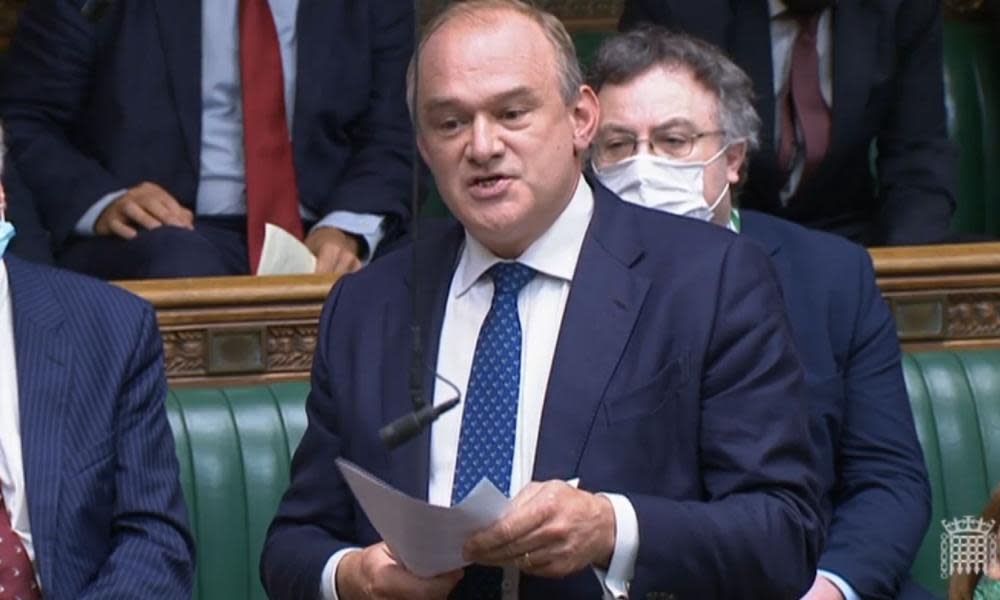The Guardian view of Lib Dem strategy: bringing down the ‘blue wall’

Electoral history is full of upsets, but few are as stunning as the Liberal Democrats’ byelection victory in Chesham and Amersham, deep in the heart of Tory Britain. In June there was a 25% swing against the ruling party and a study by the UK in a Changing Europe thinktank this week calculated that more than 30 Tory MPs would be vulnerable if such a revolt were repeated. With their party conference starting on Friday, the Liberal Democrats are determined to make that win just the first step in bringing down the Conservatives’ “blue wall”.
While there are causes for optimism, one ought to be realistic. The Lib Dems have 12 MPs. Sir Ed Davey is the party’s fourth leader in six years. He will not be telling delegates this weekend to go back to their constituencies and “prepare for government”. But there are good reasons to believe something is happening. The local election results in May signalled Lib Dem gains at the expense of the Conservatives.
Boris Johnson’s authoritarian and populist Tory party, designed to appeal to a new coalition of voters, has alienated large parts of its traditional base. When our correspondent canvassed with Lib Dems in the leafy Surrey marginal seat of the deputy prime minister, Dominic Raab, not a single voter professed loyalty to the Tory MP. Voters can punish those who take them for granted.
Mr Johnson’s record of incompetence and his broken promises are a turn-off for many voters, but especially would-be Tories attracted to the “compassionate Conservatism” of past leaders. Sir Ed has a personal story to tell such an electorate who are interested in helping, not blaming, others. He not only cared for his terminally ill mother as a boy but is a carer for his disabled teenage son. Many of the socially liberal Tories in the “blue wall” were remainers who gave Mr Johnson the benefit of the doubt in 2019. Having witnessed his chaotic government, they are unlikely to do so again.
The Lib Dem leader is positioning his party as an anti-Tory force, vowing not to put the Conservatives back into Downing Street – unlike his predecessor Nick Clegg. The Lib Dems are in second place in around 90 seats, and in 80 of those the party is behind the Tories. While a formal “progressive alliance” with the other left-leaning Labour and Green parties has been ruled out, the Lib Dems need those voters to win seats.
History, geography and demography are on Sir Ed’s side. Lib Dem target seats are concentrated in a “yellow halo” around London, where voters overwhelmingly backed remain in the 2016 referendum. The Lib Dems have struggled in the past decade to find a core vote. The UK in a Changing Europe suggests “[the party] may now have found one in (disproportionately home-owning) graduates … voters likely to be receptive to a message that is less economically radical but instead centred on social liberal attitudes and a competence critique of the government”.
Mr Johnson can’t be ejected from Downing Street without a Lib Dem revival. The next general election is probably some way off. The prime minister claims he will be “building back better” post-Covid, yet that seems to involve returning to stressed public services.
The Lib Dems will use this weekend to lay out a new social contract, saying the pandemic has wrecked the old one. This is a good strategy. While Labour and the Lib Dems cannot openly work together, there must be a shared desire not to give another century to the Tories by splitting the progressive vote. Sir Ed wants to reap the discontent in Conservative seats over Mr Johnson’s lack of integrity and honesty. One can only hope he succeeds.

 Yahoo News
Yahoo News 
